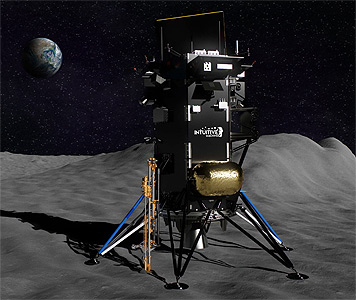Thank you very much for visiting Gunter's Space Page. I hope that this site is useful and informative for you.
If you appreciate the information provided on this site, please consider supporting my work by making a simple and secure donation via PayPal. Please help to run the website and keep everything free of charge. Thank you very much.
Nova-C IM-2 (PRIME 1, CLPS 3)

Nova-C IM-2 (PRIME 1) [Intuitive Machines]
Nova-C IM-2 or PRIME-1 (Polar Resources Ice Mining Experiment-1) is a NASA mission to land two instruments on the moon using Intuitive Machines' Nova-C commercial lunar lander on the Nova-C IM-2 mission.
The Polar Resources Ice Mining Experiment-1 (PRIME-1) will be the first in-situ resource utilization demonstration on the Moon. Additionally, for the first time, NASA will robotically sample and analyze for ice from below the surface. The landing site will be near the lunar South Pole on a ridge not far from Shackleton crater
The data from PRIME-1 will help scientists understand in-situ resources on the Moon, including resource location mapping. PRIME-1 contributes to NASA’s search for water at the Moon’s poles, supporting the agency’s plans to establish a sustainable human presence on the Moon by the end of the decade.
Following instruments are on board:
- The Regolith and Ice Drill for Exploring New Terrain (TRIDENT): TRIDENT will drill up to 1 meter deep, extracting lunar regolith, or soil, up to the surface. The instrument can drill in multiple segments, pausing and retracting to deposit cuttings on the surface after each depth increment.
- Mass Spectrometer observing lunar operations (MSolo): This modified-for-spaceflight, commercial-off-the-shelf mass spectrometer will evaluate the drill cuttings for water and other chemical compounds. Soil samples from multiple depths will be analyzed.
- Laser Retroreflector Array (LRA) is a series of eight small mirrors to measure distance and support landing accuracy. It requires no power or communications from the lander and can be detected by future spacecraft orbiting or landing on the Moon.
Versions of TRIDENT and MSolo will also fly on NASA’s VIPER rover mission that will search for ice at the lunar South Pole in 2024. PRIME-1’s early use of the drill and MSolo helps to increase the likelihood of reliable operation of those payloads on VIPER’s mobile platform in the following year.
While PRIME-1 will investigate the resources below the lunar surface, Nokia will set out to test its space-hardened 4G/LTE network. A small rover developed by Lunar Outpost will venture more than a mile away from the Nova-C lander and test Nokia’s wireless network at various distances. The rover will communicate to a base station located on Nova-C, and the lander will communicate data back to Earth. This demonstration could pave the way for a commercial 4G/LTE system for mission-critical communications on the lunar surface. This includes communications and even high-definition video streaming from astronauts to base stations, vehicles to base stations, and more.
Nearby, Intuitive Machines’ Micro-Nova will aim to deploy to the surface and hop into a nearby crater to acquire pictures and science data before hopping out. It will then send the data back to Nova-C. Micro-Nova can carry a two-pound payload more than 1.5 miles to access lunar craters and enable high-resolution surveying of the lunar surface. This demonstration could help pave the way for additional commercial lunar exploration services. In the future, scientists may have the opportunity to outfit a hopper with their own small science instruments, such as cameras, seismometers, lunar ranging systems, and more.
| Nation: | USA |
|---|---|
| Type / Application: | Lunar lander |
| Operator: | Intuitive Machines |
| Contractors: | Intuitive Machines |
| Equipment: | TRIDENT, MSolo |
| Configuration: | Nova-C |
| Propulsion: | VR900 |
| Power: | Solar cells, batteries |
| Lifetime: | |
| Mass: | ~2000 kg |
| Orbit: |
| Satellite | COSPAR | Date | LS | Launch Vehicle | Remarks | |
|---|---|---|---|---|---|---|
| Nova-C IM-2 (PRIME 1, CLPS 3) | - | 2024 | CCK LC-39A | Falcon-9 v1.2 (Block 5) | with Sherpa-ES 1, Lunar Trailblazer, Odin, (Lunar Com Sat) |
References:
- Intuitive Machines:
- NASA: Polar Resources Ice Mining Experiment-1 (PRIME-1), 16 October 2020
